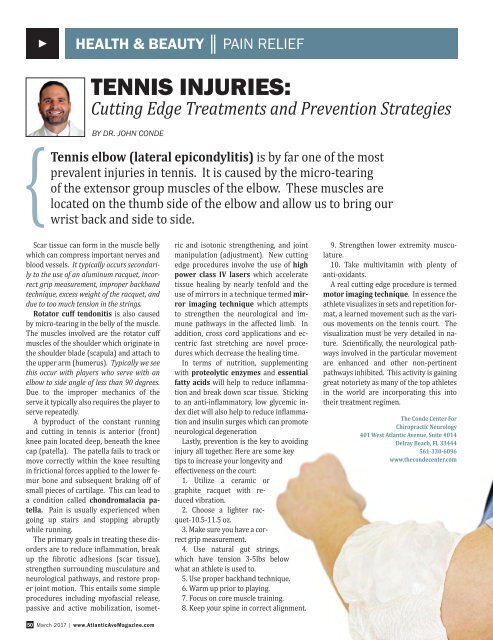You also want an ePaper? Increase the reach of your titles
YUMPU automatically turns print PDFs into web optimized ePapers that Google loves.
►<br />
health & beauty ║ pain relief<br />
{<br />
Tennis Injuries:<br />
Cutting Edge Treatments and Prevention Strategies<br />
By Dr. John Conde<br />
Tennis elbow (lateral epicondylitis) is by far one of the most<br />
prevalent injuries in tennis. It is caused by the micro-tearing<br />
of the extensor group muscles of the elbow. These muscles are<br />
located on the thumb side of the elbow and allow us to bring our<br />
wrist back and side to side.<br />
50 <strong>March</strong> <strong>2017</strong> | www.<strong>Atlantic</strong><strong>Ave</strong>Magazine.com<br />
Scar tissue can form in the muscle belly<br />
which can compress important nerves and<br />
blood vessels. It typically occurs secondarily<br />
to the use of an aluminum racquet, incorrect<br />
grip measurement, improper backhand<br />
technique, excess weight of the racquet, and<br />
due to too much tension in the strings.<br />
Rotator cuff tendonitis is also caused<br />
by micro-tearing in the belly of the muscle.<br />
The muscles involved are the rotator cuff<br />
muscles of the shoulder which originate in<br />
the shoulder blade (scapula) and attach to<br />
the upper arm (humerus). Typically we see<br />
this occur with players who serve with an<br />
elbow to side angle of less than 90 degrees.<br />
Due to the improper mechanics of the<br />
serve it typically also requires the player to<br />
serve repeatedly.<br />
A byproduct of the constant running<br />
and cutting in tennis is anterior (front)<br />
knee pain located deep, beneath the knee<br />
cap (patella). The patella fails to track or<br />
move correctly within the knee resulting<br />
in frictional forces applied to the lower femur<br />
bone and subsequent braking off of<br />
small pieces of cartilage. This can lead to<br />
a condition called chondromalacia patella.<br />
Pain is usually experienced when<br />
going up stairs and stopping abruptly<br />
while running.<br />
The primary goals in treating these disorders<br />
are to reduce inflammation, break<br />
up the fibrotic adhesions (scar tissue),<br />
strengthen surrounding musculature and<br />
neurological pathways, and restore proper<br />
joint motion. This entails some simple<br />
procedures including myofascial release,<br />
passive and active mobilization, isometric<br />
and isotonic strengthening, and joint<br />
manipulation (adjustment). New cutting<br />
edge procedures involve the use of high<br />
power class IV lasers which accelerate<br />
tissue healing by nearly tenfold and the<br />
use of mirrors in a technique termed mirror<br />
imaging technique which attempts<br />
to strengthen the neurological and immune<br />
pathways in the affected limb. In<br />
addition, cross cord applications and eccentric<br />
fast stretching are novel procedures<br />
which decrease the healing time.<br />
In terms of nutrition, supplementing<br />
with proteolytic enzymes and essential<br />
fatty acids will help to reduce inflammation<br />
and break down scar tissue. Sticking<br />
to an anti-inflammatory, low glycemic index<br />
diet will also help to reduce inflammation<br />
and insulin surges which can promote<br />
neurological degeneration<br />
Lastly, prevention is the key to avoiding<br />
injury all together. Here are some key<br />
tips to increase your longevity and<br />
effectiveness on the court:<br />
1. Utilize a ceramic or<br />
graphite racquet with reduced<br />
vibration.<br />
2. Choose a lighter racquet-10.5-11.5<br />
oz.<br />
3. Make sure you have a correct<br />
grip measurement.<br />
4. Use natural gut strings,<br />
which have tension 3-5lbs below<br />
what an athlete is used to.<br />
5. Use proper backhand technique.<br />
6. Warm up prior to playing.<br />
7. Focus on core muscle training.<br />
8. Keep your spine in correct alignment.<br />
9. Strengthen lower extremity musculature.<br />
10. Take multivitamin with plenty of<br />
anti-oxidants.<br />
A real cutting edge procedure is termed<br />
motor imaging technique. In essence the<br />
athlete visualizes in sets and repetition format,<br />
a learned movement such as the various<br />
movements on the tennis court. The<br />
visualization must be very detailed in nature.<br />
Scientifically, the neurological pathways<br />
involved in the particular movement<br />
are enhanced and other non-pertinent<br />
pathways inhibited. This activity is gaining<br />
great notoriety as many of the top athletes<br />
in the world are incorporating this into<br />
their treatment regimen.<br />
The Conde Center For<br />
Chiropractic Neurology<br />
401 West <strong>Atlantic</strong> <strong>Ave</strong>nue, Suite #014<br />
Delray Beach, FL 33444<br />
561-330-6096<br />
www.thecondecenter.com


















